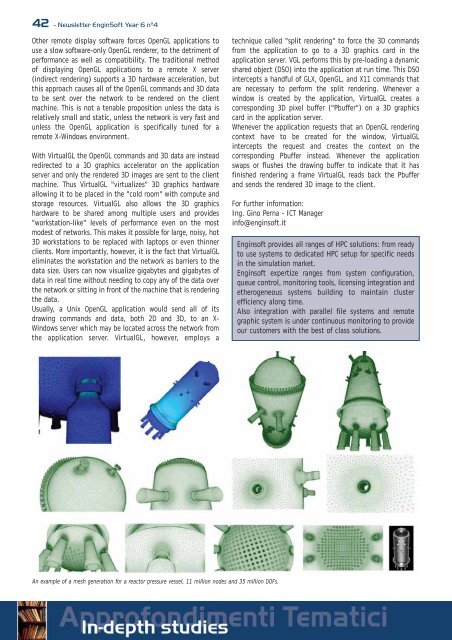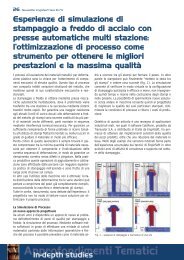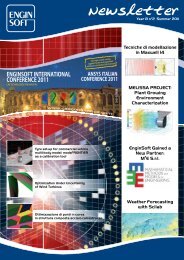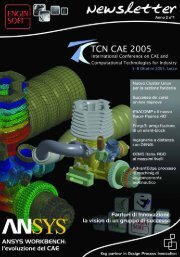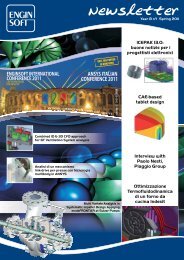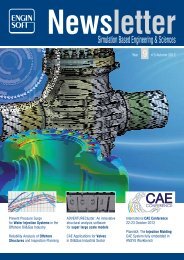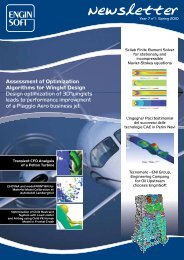software training courses 2010 corsi di addestramento ... - EnginSoft
software training courses 2010 corsi di addestramento ... - EnginSoft
software training courses 2010 corsi di addestramento ... - EnginSoft
Create successful ePaper yourself
Turn your PDF publications into a flip-book with our unique Google optimized e-Paper software.
42 - Newsletter <strong>EnginSoft</strong> Year 6 n°4<br />
Other remote <strong>di</strong>splay <strong>software</strong> forces OpenGL applications to<br />
use a slow <strong>software</strong>-only OpenGL renderer, to the detriment of<br />
performance as well as compatibility. The tra<strong>di</strong>tional method<br />
of <strong>di</strong>splaying OpenGL applications to a remote X server<br />
(in<strong>di</strong>rect rendering) supports a 3D hardware acceleration, but<br />
this approach causes all of the OpenGL commands and 3D data<br />
to be sent over the network to be rendered on the client<br />
machine. This is not a tenable proposition unless the data is<br />
relatively small and static, unless the network is very fast and<br />
unless the OpenGL application is specifically tuned for a<br />
remote X-Windows environment.<br />
With VirtualGL the OpenGL commands and 3D data are instead<br />
re<strong>di</strong>rected to a 3D graphics accelerator on the application<br />
server and only the rendered 3D images are sent to the client<br />
machine. Thus VirtualGL "virtualizes" 3D graphics hardware<br />
allowing it to be placed in the "cold room" with compute and<br />
storage resources. VirtualGL also allows the 3D graphics<br />
hardware to be shared among multiple users and provides<br />
"workstation-like" levels of performance even on the most<br />
modest of networks. This makes it possible for large, noisy, hot<br />
3D workstations to be replaced with laptops or even thinner<br />
clients. More importantly, however, it is the fact that VirtualGL<br />
eliminates the workstation and the network as barriers to the<br />
data size. Users can now visualize gigabytes and gigabytes of<br />
data in real time without nee<strong>di</strong>ng to copy any of the data over<br />
the network or sitting in front of the machine that is rendering<br />
the data.<br />
Usually, a Unix OpenGL application would send all of its<br />
drawing commands and data, both 2D and 3D, to an X-<br />
Windows server which may be located across the network from<br />
the application server. VirtualGL, however, employs a<br />
technique called "split rendering" to force the 3D commands<br />
from the application to go to a 3D graphics card in the<br />
application server. VGL performs this by pre-loa<strong>di</strong>ng a dynamic<br />
shared object (DSO) into the application at run time. This DSO<br />
intercepts a handful of GLX, OpenGL, and X11 commands that<br />
are necessary to perform the split rendering. Whenever a<br />
window is created by the application, VirtualGL creates a<br />
correspon<strong>di</strong>ng 3D pixel buffer ("Pbuffer") on a 3D graphics<br />
card in the application server.<br />
Whenever the application requests that an OpenGL rendering<br />
context have to be created for the window, VirtualGL<br />
intercepts the request and creates the context on the<br />
correspon<strong>di</strong>ng Pbuffer instead. Whenever the application<br />
swaps or flushes the drawing buffer to in<strong>di</strong>cate that it has<br />
finished rendering a frame VirtualGL reads back the Pbuffer<br />
and sends the rendered 3D image to the client.<br />
For further information:<br />
Ing. Gino Perna - ICT Manager<br />
info@enginsoft.it<br />
An example of a mesh generation for a reactor pressure vessel, 11 million nodes and 35 million DOFs.<br />
Enginsoft provides all ranges of HPC solutions: from ready<br />
to use systems to de<strong>di</strong>cated HPC setup for specific needs<br />
in the simulation market.<br />
Enginsoft expertize ranges from system configuration,<br />
queue control, monitoring tools, licensing integration and<br />
etherogeneous systems buil<strong>di</strong>ng to maintain cluster<br />
efficiency along time.<br />
Also integration with parallel file systems and remote<br />
graphic system is under continuous monitoring to provide<br />
our customers with the best of class solutions.


